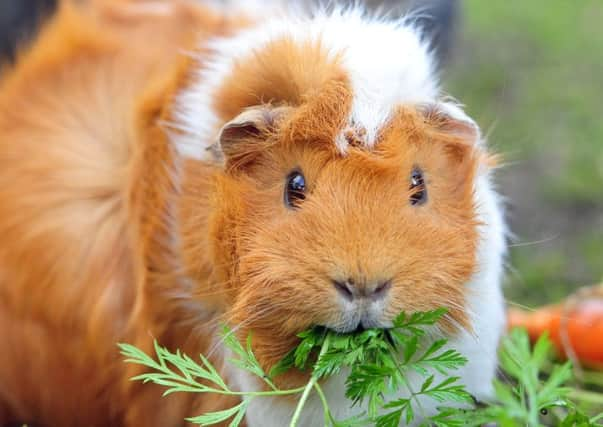Guinea pigs prone to many skin conditions


These little animals are regular patients in our practice, and are frequently presented to us with skin and/or coat problems. These can have several different causes, and sometimes guinea pigs are plagued by more than one at a time.
Here are examples of the most common skin diseases in guinea pigs:
Ectoparasites
Advertisement
Hide AdAdvertisement
Hide AdMites – The sarcoptic mite causes extreme itching by burrowing into the skin. This is very stressful for the guinea pig and can lead to self-mutilation and to secondary bacterial or fungal infections. Unfortunately, this mite can also transiently infest humans, and can be transferred from guinea pig to owner. Lesions are primarily found on thighs, hip area, and back, but can also extend to the shoulders.
Lice – Lice feed on debris of skin. Adults and their eggs are attached to the guinea pig’s hair. A lice infestation can lead to irregular hairless spots, crusty skin and a rough coat.
Fleas – Guinea pigs can get the same fleas as rabbits and cats. A flea bite can not only cause itching, it might also lead to an allergic reaction to flea saliva, which will show as eczema on the guinea pig’s skin. Therefore make sure you check on your pig if you find fleas or flea dirt on one of your other furry companions.
All of these parasites are transmitted by direct contact. When your guinea pig is treated for ectoparasites make sure their environment is also thoroughly cleaned. This includes hay, toys, and bedding.
Ringworm
Advertisement
Hide AdAdvertisement
Hide AdThe so-called dermatophytosis, or ringworm, is frequently seen in guinea pigs. Mainly caused by two different species of fungi, this skin condition usually becomes apparent when their host has an impaired or naive immune system. This might be due to young age, overcrowding, stress or poor husbandry. Symptoms include hairless spots, sometimes crusty spots, foremost seen on face, forehead and ears, but can later spread to other parts of the body.
Bite wounds
Despite the fact that guinea pigs are very social animals, the occasional fight can lead to the formation of abscesses under the skin. This is treated by draining and irrigating the abscess, and the guinea pig will need to be given antibiotics.
Bumblefoot
This condition, with the medical term pododermatitis, is caused by a combination of unsuitable husbandry conditions. Wire-bottom cages and abrasive bedding leads to sores, which develop into painful ulcers on the underside of the feet. In extreme cases, the resulting infection can ascend from the skin to deeper tissue, like ligaments, tendons and even bones. Overweight guinea pigs are at a higher risk to develop bumblefoot.
Prevention is more important than treatment so make sure you keep an eye on your guinea pig’s weight and provide it with soft and dry bedding.
Hair loss
Advertisement
Hide AdAdvertisement
Hide AdSymmetrical hair loss over the hips of females can be due to ovarian cysts. After removing the ovaries surgically, the hair can grow back. Pregnant females sometimes show similar bald spots during late pregnancy.
Barbering by dominant cage mates or nursing pups, and self-barbering due to boredom must be distinguished from barbering because of itching. Barbering caused by boredom can be improved by environmental enrichment.
A vitamin deficiency, in particular a lack of vitamin C, can not only lead to a poor coat, but can also be responsible for loose teeth, loss of appetite, diarrhoea, bruising, slow wound healing and increased susceptibility for bacterial infections.